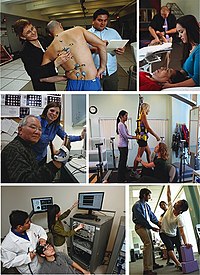
Photo from wikipedia
Descriptive and functional anatomy is one of the most important sciences for kinesiology students. Anatomy learning requires spatial and motor imagery abilities. Learning anatomy is complex when teaching methods and… Click to show full abstract
Descriptive and functional anatomy is one of the most important sciences for kinesiology students. Anatomy learning requires spatial and motor imagery abilities. Learning anatomy is complex when teaching methods and instructional tools do not appropriately develop spatial and motor imagery abilities. Recent technological developments such as three‐dimensional (3D) digital tools allow to overcome those difficulties, especially when 3D tools require strong interactions with the learners. Besides interactive digital tools, embodied learning or learning in motion is an effective method for a wide variety of sciences including anatomy. The aim of this study was to explore the impact of combining movement execution with 3D animation visualization on anatomy learning in a real classroom teaching context. To do so, the results of two groups of kinesiology students during three official assessments were compared. The experimental group (n = 60) learned functional anatomy by combining movement execution with traditional knowledge acquisition (e.g., 3D animations visualization, problem‐based learning exercises). The control group (n = 61) had the same material but did not execute the movements during problem‐solving exercises. Although no differences were found between both groups on early and mid‐semester examinations, significant difference appeared at the end of the semester with an advantage for the experimental group. This exploratory study suggests that embodied learning is beneficial in improving functional anatomy learning. Therefore, it would be interesting to integrate such type of pedagogical approach within the kinesiology curriculum.
Journal Title: Anatomical Sciences Education
Year Published: 2022
Link to full text (if available)
Share on Social Media: Sign Up to like & get
recommendations!